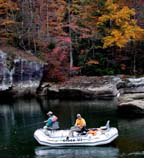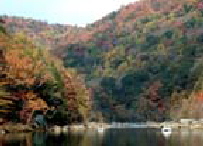|
White Water Class
Guided Fishing Trips for the Serious Fisherman
by Larry Larsen (c)
 West Virginia's rivers offer a variety of fish in abundance. The hard-fighting smallmouth bass finds prime habitat in the rock
ledges and structured banks of the New River, which has gained national recognition as one of the premier smallmouth streams in the country. A little further north the cold waters of the Gauley
River shelter the gigantic, elusive muskie. Whatever your preference, fishing trips for the entire family are one of the most enjoyable ways to experience the beautiful rivers at a more
leisure pace. West Virginia's rivers offer a variety of fish in abundance. The hard-fighting smallmouth bass finds prime habitat in the rock
ledges and structured banks of the New River, which has gained national recognition as one of the premier smallmouth streams in the country. A little further north the cold waters of the Gauley
River shelter the gigantic, elusive muskie. Whatever your preference, fishing trips for the entire family are one of the most enjoyable ways to experience the beautiful rivers at a more
leisure pace.
We recently spent a couple of days floating the New River and the Top Gauley River in search of smallmouth bass. The New River offers anglers the opportunity to catch
larger fish, while the smaller, lesser known Top Gauley River offers a serene tranquility all its own. Two rafts with two anglers each day boated a respectable number of fish
- 100 in the New River, and 150 in the Top Gauley. We didn't find any muskie on either day, but we did catch rainbow trout, rock bass and numerous smallmouth ranging from 10 inches to 17 inches.
Timing and Location
Finding fish on the New and Gauley Rivers is not always easy, according to our river guide. A quick increase or decrease in water flow usually
moves the fish. When the water drops quickly, they will move out to the deeper areas where it is more difficult to locate them. After it stabilizes, they start moving
back into the areas where you generally catch them. When the water levels increase quickly, the fish move to areas where they can get away from the high water and the
force of the increased current. The water temperature is dropping and the fish try to conserve energy if the water level rises.
After a day of steady water level, you can generally catch them near the bank. They come in and start feeding in the areas they have not been able to reach before the
rise in the water. There is an abundance of bugs and larger crustaceans like crayfish and hellgrammites as well as baitfish. While the smaller fish feed on bugs, smallmouth
over 14 inches generally feed on the forage fish.
 In the fall, cold fronts will typically turn off the fish. Once the front is on
top of you, a windy day shuts the smallmouth fishing down. Rain generally has a better chance of turning them on than turning them off. In the fall, cold fronts will typically turn off the fish. Once the front is on
top of you, a windy day shuts the smallmouth fishing down. Rain generally has a better chance of turning them on than turning them off.
"We catch in excess of 80 in that range each year," says our guide. "Success here can depend on the skill of the fisherman and whether or
not they listen to the guide. Good fishermen sometimes fish the wrong bait and are not keen on changing to what the guide suggests. Sometimes the fish just don't
cooperate; it's the only sport where the other team doesn't have to participate!"
"To have a great day on the river, you need to pay attention," he continues. "When you're float fishing a moving river with a lot of structure, you need to be flexible and
understand how the current affects the position of the fish. Our job is to make sure people know where to cast, and hopefully they get accurate enough over a period of
making 2 or 3 thousand casts to catch a lot of fish."
Accuracy Counts
Inexperienced anglers generally improve enough over the course of a day to where they can pinpoint casts better. In some places, the most productive spots are only
two feet deep and 18 inches wide. The successful angler has only one cast to get the lure into the spot because the boat normally moves quickly through a rapid. It is vital
in those areas to be able to accurately cast the lure to where it needs to be to catch the fish.
"Presentation of that lure on the Gauley in most instances requires that you have some accurate capabilities of casting," he warns. "You also may value a quick retrieve
reel. Some people use the slow retrieve reels, and they work themselves to death."
 "When the fish are hitting really well, you catch a lot of
them in the moving water and tight little coves, but the bigger bass are typically in the quiet pools," he points out. "You don't catch as many fish in the deep pools, but if you
want to catch a bigger fish, you have to pay the dues. You're making a lot of casts and getting fewer fish in the pools." "When the fish are hitting really well, you catch a lot of
them in the moving water and tight little coves, but the bigger bass are typically in the quiet pools," he points out. "You don't catch as many fish in the deep pools, but if you
want to catch a bigger fish, you have to pay the dues. You're making a lot of casts and getting fewer fish in the pools."
If fish are aggressive, they are going to be in areas such as the shallow rocky flats, or they are going to be tight on the edge of the bank
looking for the crayfish. They may be out towards the middle of the river in the deep or in the flats chasing baitfish. It is difficult to present some lures to the fish. Usually
the big fish are holding where the bank drops off into the deep. The angler will get a quick reaction strike when he casts and starts the retrieve before the lure splashes
down. The optimal riverbank is a rocky one where the bottom drops off at a 60-degree angle from a narrow flat.
On the New River, guides have caught and released smallies that pushed 8 pounds on the scales. The Gauley River is known as having smaller smallmouth but a large
variety of fish. It does not harbor the size smallmouth that the New does, but the numbers of Gauley fish caught can be quite impressive. The most our guide and two
clients have taken in one day is 300 smallmouth, but that was an exceptional day. We should all be so lucky!
So, get off the bank and cast from a padded swivel seat as the guide rows the raft
through pools, eddies, shoals, and rapids where great fishing can be found. For more information on guided fishing trips and/or whitewater rafting trips, call Class VI at 800
-252-7784 or visit http://www.800classvi.com.
|